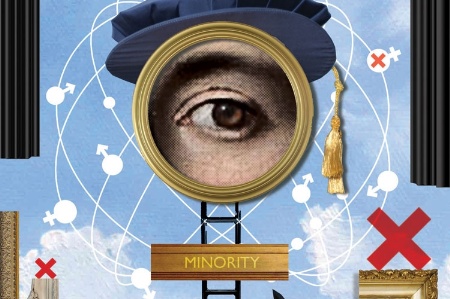Source: Paul Bateman
Interview panels often offer the view that female candidates are ‘not quite ready’, but the same comments are not made about men.
Jack Grove reports on critiques of the senior management boys’ club.
What does a university’s art collection say about the institution? Dame Julia King, vice-chancellor of Aston University, believes that the pictures found in corridors and common rooms reveal much about the male-dominated culture of Britain’s universities.
“If you walk around most universities, you will see portraits of elderly men on the walls,” observes King, who believes that the lack of female faces can make women feel as though they are intruding in an all-male domain.
“When I was appointed at Aston, I commissioned 50 portraits of our staff – men and women – and these are now the beautiful people who are on our walls,” she says.
Vetting paintings to ensure parity of the sexes might be dismissed by some as “political correctness gone mad”, but King believes such steps are needed to help break down deeply rooted negative attitudes towards women in universities, particularly when it comes to appointing them to senior roles.
Speaking at The “Missing Women” in Higher Education Leadership conference at Lancaster University earlier this summer, King said that a large part of the problem was the entrenched notion that men were more “natural” leaders than women – something exacerbated by the increasing use of generally male-led headhunting firms, who report to male-led academic boards.
“When [they] interview, [they have a] picture of who [they] are going to appoint – and it is a man,” King said.
Interview panels often offer the view that female candidates are “not quite ready”, but the same comments are not made about men, she claimed.
“Why is that? Is it a paternalistic attitude that women are to be protected from the challenges ahead?” she asked.
Pat O’Connor, professor of sociology and social policy at the University of Limerick, interviewed 40 university leaders and senior staff at universities in the Republic of Ireland for a study on perceptions of female leaders in higher education in 2011.
She told the conference that many men seemed resistant to the idea of women joining their executive ranks.
“Senior management was seen as a boys’ club – men wanted to work with men.
“This was seen as legitimate continuation of the status quo, but men were effectively cloning themselves in their image,” she said of senior appointments.
Despite her focus on Irish universities, O’Connor believed that similar attitudes are to be found in the UK sector, since it has roughly the same proportion of female university leaders, professors and staff as Ireland, where she said female vice-chancellors are seen as similar to a “fish on a bicycle”: “a marvel, but a freak”.
Other interviewees felt that women tended to be more caring, and were therefore better suited to and naturally drawn towards teaching duties. But one man claimed that “teaching is the new housework”.
And some male interviewees said that they wanted to spare women the “rough and tumble” of leadership – a typical example of “heroic, paternalistic masculinity”, O’Connor reported.
However, several participants advanced the theory that it was not male bias that prevented more women from leading universities but women’s refusal to “play the games” needed to reach the top.
“Promotion is a game but women don’t play those games,” one interviewee told O’Connor.
“Women are poor at getting themselves and their achievements recognised,” the same interviewee contended.
O’Connor also reported that female university leaders were often described as “frightening” by their staff – an adjective King said she had also had to contend with. By contrast, men taking leadership decisions were viewed as determined, committed, passionate or strong-willed.
“It is used as pushback, to say ‘I have been intimidated into doing something’ rather than conceding that you have persuaded them by advancing arguments based on logic that people find it hard to disagree with,” King told the conference.
“These things seem like trivia but accumulated trivia can be very stressful.
“People don’t realise how easy it is to be ground down by these types of comments.”
Such resistance to female leadership might prevent more women reaching the top in higher education but King believes that wider economic factors may play a part, too.
With hard financial times ahead for the sector, universities may increasingly look for a “safe pair of hands” for their next vice-chancellor, preferably one with a bit of commercial know-how, she said.
“Institutions have changed their focus, so instead of a research [record], their boards want someone with business experience,” said King, herself a former Rolls-Royce executive.
“Boards of governors…will look outside the academic sector [for a leader] and then you are looking in a world [that is even] more male-dominated.”
This trend might help to explain why there are now just two female vice-chancellors in her West Midlands region compared with the five when she started at Aston in 2006.
Other seemingly non-gendered policy decisions might also have very gendered effects unless institutions are careful, she added.
There is a risk that some departmental heads under pressure to hit budget targets might think twice about employing a young woman who might require maternity cover if their institution did not make any allowance for it, she said.
But the Lancaster conference also heard that the sector was making some progress on the equity front.
David Ruebain, chief executive of the Equality Challenge Unit, said he was very encouraged by the popularity of the organisation’s Athena SWAN scheme, which promotes women in science.
It had received more than 100 applications from institutions in its latest biannual round (there are currently only 179 departmental holders in the scheme’s eighth year). The surge in demand has been partly prompted by the Department of Health’s decision to require any institution in the £800 million Biomedical Research Units and Centres scheme to have a silver Athena SWAN award if it is to be eligible for funding in 2015.
“Some institutions are undertaking [applications] to maximise their chances of accessing research funds,” Ruebain said.
That decision, announced in October 2011, had given the ECU a “quasi-regulatory role” at odds with its initial purpose as a voluntary scheme, but the move had certainly galvanised institutions into addressing gender issues on campus, he reported.
Sum difference: women by numbers
- Just 14 per cent of UK vice-chancellors are women.
- Only one of the 24 large research-intensive institutions that make up the Russell Group – the University of Manchester – is female-led.
- One in five professors in the UK is female, but data obtained and published by Times Higher Education earlier this year indicate that at some institutions just one in 10 academics at professorial level is a woman.

My own experience has made me conscious of the choices women must make, and keen to help others progress.
Bucks New University v-c Ruth Farwell calls for champions and mentors.
A lot of attention is being directed at the lack of women in leadership in UK higher education, and rightly so. The under-representation of women in such positions seems nothing short of a scandal, given the percentage of students who are female (about 60 per cent) and the proportion working as academics and in professional services. After all, we are in 2013, not the Dark Ages.
As one of the UK’s few female vice-chancellors, I am often asked to reflect on my story and how I got to be where I am. I am always happy to draw out some of the lessons I have learned and tips to pass on, especially to young women who have yet to embark on their careers or are in the early stages.
In many ways I have had a fairly straightforward and predictable career. I have always worked in higher education and I have progressed through the ranks, gradually being appointed to more senior positions. It may look as though I had it all mapped out from a young age, but it wasn’t really like that.
My career as an academic began after I completed my PhD at the University of Kent. I knew then that I wanted to continue what I was already doing and liked doing, namely researching in mathematics. I won two research fellowships, one for a year at Kent and then at Imperial College London. As a postdoctoral fellow in applied mathematics bordering on theoretical physics, I found women were always very much in the minority in the departments I worked in. In fact “missing women” became such a familiar part of my existence that later in my career I almost had to teach myself to recognise their absence – because I wanted to take positive steps to challenge what otherwise might have been taken to be “normal”.
When the second fellowship was coming to an end, I took stock and started to think about where all of this might be leading. I looked around at my contemporaries and realised that fellowships did not necessarily lead anywhere or, if they did, it was literally (geographically) somewhere else. Looking back, I can see that location has nearly always been a factor in my decision-making because I wanted to take into account the location of my partner’s working base. In that sense I have self-imposed constraints on my career, which may well have inhibited it.
While I wanted to carry on doing what I enjoyed, I also wanted to start putting down roots and be in a university as a permanent member of staff. That was difficult in the early 1980s. There was no expansion of student numbers and in maths there was even contraction. So I thought a bit laterally and took a job at what is now St Mary’s University College in Twickenham. Historically the college had exclusively offered teacher training, but it had gone on to develop a wider focus as a college of higher education. At the time, it did not have the same esteem as a university, but it had aspirations, and it was where I got my first permanent job as a maths lecturer.
A few years later my boss decided that he wanted to retire early. I was still relatively young, but he encouraged me to apply for his job as head of department, and I got it. Becoming a head of department at a small institution gave me the freedom to expand my role and work beyond my remit, so I did. I was able to do things and acquire experience in a way that might not have been possible in a larger place. So I learned a big lesson there, and that is to take advantage of every opportunity to gain skills and knowledge, even when they are not necessarily part of your regular job.
I used those additional skills to get my next job at the University of Brighton. Gradually I was doing less teaching and more management. I stayed there for eight years in four different roles, moving about halfway through my time there to the central management. But I wanted to rise up the ranks, and it took another move to get to the next level as dean at London South Bank University, where I went on to become a pro vice-chancellor. I still had ambitions, though, and after a few attempts, I secured my current position.
So it was not all planned out from the beginning; at each stage, it was about moving on to the next one. I also learned to recognise that progression is not always about taking the obvious steps – it isn’t necessarily about moving directly upwards; sometimes you have to move diagonally, too.
I am lucky that my bosses have always been incredibly supportive, helping me to achieve my career goals – right from the start with that head of department who encouraged me to think that I could be his successor. This is incredibly important and I would always advocate doing your best to find a good mentor: someone to champion you and be your supporter at work. All of the vice-chancellors with whom I worked helped me to believe that I, too, could be a vice-chancellor, and as I have become more senior, I have made a point of supporting other women to help them progress in their careers and achieve their aspirations.
Have I made compromises and mistakes? As a woman, have I had to face dilemmas? Have I encountered conflicting loyalties and demands with my personal and professional life? The answer to all of these questions is “yes”. I have often asked myself whether I was sufficiently ambitious and whether I stayed too long in each of my jobs. Others would have been more impatient, I am sure, and I do not just mean men. However, I think it is important that you do not regret decisions.
I have elected to try to balance my work and my personal life later on in my career. My first long-term relationship failed basically because the two of us were more dedicated to our work than to making time for each other. The next time around I did not want to make the same mistakes. Having tried to live “split lives” and to attempt weekend commuting for a couple of periods in my career, I knew that I did not want to do it again. However, rejecting that usually means that one or other partner faces a limit in their choice of jobs. I have been lucky in that when I went for that last push to be a head of institution, my husband was prepared to move to enable me to progress. That isn’t always possible and different stages and circumstances in people’s lives, such as having young children at school, place different restrictions on both men and women.
My own experience has made me very conscious of the choices women have to make, and keen to help other women progress. I also recognise that, to an extent, being ambitious about your career involves making some compromises; you need to find a satisfactory modus operandi. I chose not to have children and that has suited me but it does not suit everyone. If anything, the decision has made me all the more conscious that I should not make assumptions about the hours that people with young families are able to work.
I am proud of our gender profile at Bucks New University. Two of the five senior leadership team at the university are women, including me; 57 per cent of the next management tier are female, and 62 per cent of middle managers are female. Half of our governing board are now female, with three of the four chairs of the major board committees being women. I believe that having more diverse boards is one of the most important ways in which we can help more women become senior university leaders. After all, it is the board that decides who to appoint as head of institution. This year, I am particularly pleased that we have a female triumvirate at Bucks with Dame Christine Beasley, former chief nursing officer, as chair, myself as vice-chancellor and Naomi Franco as Bucks Students’ Union president.
Clarity, openness, respect and delivery on commitments – these are the principles through which I have led Bucks New University to date. Ultimately I hope to leave behind the legacy of a different leadership model: one that is much more values-based and in tune with people, and not “macho” in style. (I stress that I do not necessarily equate “macho” with “male”; I have known women who use a “macho” leadership style and men who do not.)
“Transformational education” is the guiding principle behind our curricula. As well as developing self- and social awareness, this is about encouraging graduates to aspire and have the confidence to be emotionally intelligent and caring leaders. I cannot safely conclude that this aspiration is a direct consequence of my being female, but I certainly believe that this model of leadership provides more opportunities for women to progress to senior positions.
Ruth Farwell is vice-chancellor and chief executive of Bucks New University.

V-cs talk about the need for a ‘critical mass’ of women in senior posts so that they do not appear or feel odd at their level.
Paula Burkinshaw spoke to the UK’s female university leaders.
In 2010 I returned to full-time education, after an enjoyable career in leadership development, to study for a PhD exploring the under-representation of women among vice-chancellors in UK higher education.
Throughout the years I spent working to support and develop leaders in different sectors, women were never fairly represented at the top. Nonetheless, when my work led me to move into the world of higher education a decade ago, I was still surprised to find a dearth of women in senior roles: this was not what I expected of a sector with a liberal culture of “thought leadership” that prides itself on freedom, respect and a commitment to equality and diversity; surely it should be leading the way? Instead, I soon discovered, universities have highly gendered leadership cultures.
Year after year, published statistics point to the persistence of the gender gap. The Equality Challenge Unit 2012 report Equality in Higher Education found that only 14 per cent of vice-chancellors and 19 per cent of professors were women, whereas women made up almost 50 per cent of early career academics and 60 per cent of students.
Thankfully, nowadays there is a growing conversation across many sectors – including finance, law, the media, the Church and the Civil Service – about the “missing women” in senior leadership. The Equality and Human Rights Commission has calculated that altogether there are 5,400 missing women in top jobs across the UK and concern about this shocking figure seems to be growing, with organisations such as the “30% Club”, a group committed to bringing more women on to UK corporate boards, springing up.
All of this led me to pursue a PhD and I have based my research on one apparently simple but critical question: “Why are there so few women vice-chancellors?” There is strong evidence that more diverse leadership teams produce more successful organisations (see, for example, McKinsey’s 2010 Women Matter report). But also – and more importantly – it is a matter of social justice that women are fairly represented at all levels and in all walks of life. A culture of fairness for women is ultimately fairer for all.
I was surprised to find very little information in the public domain about the views of female academics who have reached the top, namely the 20 or so women who are heads of higher education institutions. Their voices, it seemed, had been virtually silent. So I decided to approach these women and ask them to talk to me about their careers, their experiences of gendered leadership culture and their views on the under-representation of women in leadership. I carried out the interviews between September 2011 and March 2012.
Researching “the powerful” is not the common practice of feminist researchers. I thoroughly enjoyed my conversations with each of my participants, and felt respected by them in my role as researcher. The interviews raised many fascinating themes that will be the subject of forthcoming research papers.
More often than not, the vice-chancellors I interviewed talked about the need for a “critical mass” of women in senior leadership positions. For the interviewees, this meant a proportion sufficient for women not to appear or feel unusual, odd or strange at their level and across their peer networks. Their comments suggested that the opposite is currently true. As one of my interviewees put it: “You will walk into a room and there will be quite a high probability you are the only woman in the room. There will be quite a high probability that a woman will be interviewed by a predominately male panel. Once you get around 30 per cent it will be easier to make sure that doesn’t happen…they feel confident enough to say no, to not agree, and not feel everybody will remember them because they were the only person not wearing a grey suit in the meeting.”
On the whole, my participants were ambivalent about the idea of setting quotas to achieve this critical mass, but some had strong views about the suggestion. As one said: “I am absolutely dead set and implacably opposed to anything that has quotas or anything else that could be read as tokenistic or anything else that takes the gloss off for people who actually have achieved by their own actions and by their own good qualities.”
While another told me: “I do believe in positive action and I do believe in quotas; I believe they concentrate the mind. I’m not sure how you could enforce a quota at vice-chancellor level…but I think we, as women vice-chancellors, could be doing more to encourage the next level down and the next level down and the next level down.”
A key concern among those who oppose quotas is that they would lead women to be seen as having succeeded only because of the need to satisfy the quota. Yet many of the interviewees also said that, in their experience, women are not as likely as men to put themselves forward for promotion even when they were more than qualified, and others felt that women did not receive equal levels of sponsorship and support and were more likely to suffer from a lack of confidence than men (although my research is not about “essentialising” gender).
According to the Equality and Human Rights Commission, at the current rate of change it will be at least 70 years until women are fairly represented in the professoriate. When we discussed this finding, nearly all my respondents agreed that this was unacceptable and that something needed to be done more quickly.
Thus “gender mainstreaming” (interrogating structures, policies and practices through a gender lens) and positive action are on their agenda in order to illuminate, challenge and address the myth that higher education has a “gender-neutral” culture.
Several of my respondents are already practising positive action within their institutions even if they are not labelling it as such. For example, some have made sure that all recruitment, selection, promotion and retention committees at their university are diverse, inclusive and gender aware.
One described the importance of making sure “that you have fair processes, that you look at the data”. She continued: “I make my internal academic promotions committee every year look at the data of not only where they are but the salary. ‘Are the women at the bottom of the salary scale? What a surprise! And we know that person is really good, so why is she at the bottom?’ Once you point it out I don’t think people are negative [about doing this]. They don’t realise it’s happening.”
Another leader spoke of her belief that “you can create a culture, an environment – you see that with the Athena [SWAN] award. You can start to create a culture of expectation that expects women to deliver their best. From a leadership point of view, as a vice-chancellor I want to get the best out of my people.”
She added that such positive measures were not necessarily gender-specific: “I don’t want to think I need to do special things. Some of the things that women benefit from, so do men.”
During my research I have come across many examples of positive action, some of which were highlighted at the recent conference at Lancaster about the scarcity of women in higher education leadership, but there is still much work to be done. Worryingly, recent evidence from The Female FTSE Report 2013, prepared by Cranfield University, suggests that women’s representation at the top has recently plateaued. Its authors say there must be action if European Union intervention is to be avoided.
I feel privileged to have had the opportunity to conduct my research, and while the knowledge created with my participants is inevitably only partial, especially given the huge scale of the issue and its many facets, I hope that my findings will help to stimulate the debate and ultimately inform an agenda for genuine and lasting change.
Paula Burkinshaw is a doctoral candidate in the department of educational research at Lancaster University. She organised The “Missing Women” in Higher Education Leadership conference at Lancaster.
Register to continue
Why register?
- Registration is free and only takes a moment
- Once registered, you can read 3 articles a month
- Sign up for our newsletter
Subscribe
Or subscribe for unlimited access to:
- Unlimited access to news, views, insights & reviews
- Digital editions
- Digital access to THE’s university and college rankings analysis
Already registered or a current subscriber? Login




